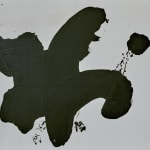Morita Shiryū (1912–1998)
Ki
Ink on paper, framed
1995
With a label signed by Inada Sousai
140 x 176 cm
143 x 179 cm (overall)
1995
With a label signed by Inada Sousai
140 x 176 cm
143 x 179 cm (overall)
Literature
Morita Shiryu Catalogue Raisonné: 1952–1998. Uji: Soryusha, 2019.
According to Inada Sousai, Morita’s last disciple, this work was an improvisation by Morita while he gave lessons to his students at a calligraphy training camp in Wakayama prefecture in 1995. Unlike Ki of 1964 (pp. 52-53) in this catalog, with its odd shape that leaves the character illegible even to the trained eye, Morita here returned to a more common style we often see in classic cursive script. One reason for this reversal may have been that it was created, as mentioned, as part of a workshop and Morita had the instruction of his students in mind. In addition, “classicism” to him meant neither just to continue traditions nor to resist or destroy them, but rather to use it as another means to self-realization.
The brushwork here looks dense and weighty as the strokes are not clearly distinguishable from one another. Ink is splattered across the paper, and a sense of movement animates the character as though Morita wrote it in a burst of strength. Near the bottom of the character, two footprints were left accidentally on the surface, bringing forth a sense of Morita’s human presence. Contemplating this work created at the age of eighty three, its raw, uninhibited energy reminds one of Morita’s overwhelmingly dynamic works of 1950s; it is also telling of the unwavering spirit that the artist carried throughout his life.
Morita Shiryu (avant-garde calligrapher; 1912–1998)
Avant-garde calligrapher from Hyogo Prefecture. Like fellow artist Inoue Yuichi, Morita studied under the calligraphy master Ueda Sokyu. He co-founded the avant-garde group Bokujinkai together with Inoue and was the founder and editor of the journal Bokubi (Beauty of Ink), both of which revolutionized traditional Japanese calligraphy and spread knowledge of Japanese avant-garde calligraphy to an international audience. He was posthumously awarded the Medal of Honor with Dark Blue Ribbon.
The brushwork here looks dense and weighty as the strokes are not clearly distinguishable from one another. Ink is splattered across the paper, and a sense of movement animates the character as though Morita wrote it in a burst of strength. Near the bottom of the character, two footprints were left accidentally on the surface, bringing forth a sense of Morita’s human presence. Contemplating this work created at the age of eighty three, its raw, uninhibited energy reminds one of Morita’s overwhelmingly dynamic works of 1950s; it is also telling of the unwavering spirit that the artist carried throughout his life.
Morita Shiryu (avant-garde calligrapher; 1912–1998)
Avant-garde calligrapher from Hyogo Prefecture. Like fellow artist Inoue Yuichi, Morita studied under the calligraphy master Ueda Sokyu. He co-founded the avant-garde group Bokujinkai together with Inoue and was the founder and editor of the journal Bokubi (Beauty of Ink), both of which revolutionized traditional Japanese calligraphy and spread knowledge of Japanese avant-garde calligraphy to an international audience. He was posthumously awarded the Medal of Honor with Dark Blue Ribbon.



